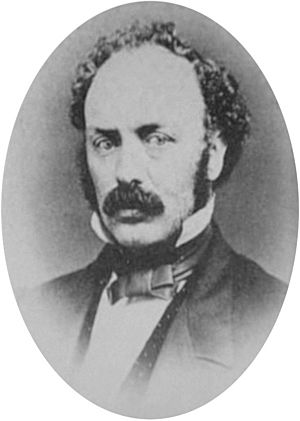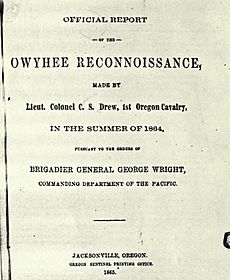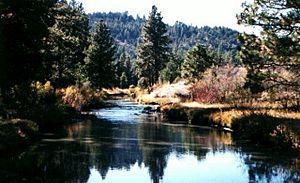Charles S. Drew facts for kids
Quick facts for kids
Charles S. Drew
|
|
|---|---|

Civil War veteran C. S. Drew in 1865
|
|
| Nickname(s) | C.S. Drew |
| Born | April 2, 1825 Bolton, Brome, Quebec, Canada |
| Died | October 25, 1886 (aged 61) Yountville, California |
| Allegiance | United States of America (Union) |
| Service/ |
Union Army |
| Years of service | 1854–1857 (Oregon militia) 1861–1865 (U.S. Army) |
| Rank | Lieutenant colonel |
| Unit | 1st Oregon Cavalry |
| Commands held | Camp Baker (Oregon); Fort Klamath |
| Battles/wars | Rogue River Indian War; American Civil War |
Charles Stewart Drew (1825 – 1886), also known as C.S. Drew, was an important figure in the early history of Oregon. He served in the government of the Oregon Territory and was in charge of supplies for the local army. During the American Civil War, he became an officer in the Union Army, reaching the rank of lieutenant colonel.
In 1864, Drew led a special Army trip, called the Owyhee Reconnaissance. This expedition explored new, unknown areas in southeastern Oregon. Drew also wrote two important reports about his military experiences. One report described attacks by Native American tribes on settlers in Oregon. The other was his detailed account of the Owyhee Reconnaissance.
Contents
Early Life and Oregon Politics
Drew was born on April 2, 1825, in Bolton, Quebec, Canada. In the early 1850s, he moved to Oregon and settled in the Rogue Valley. By 1853, he was selling supplies to the Rogue River Native American people.
Drew became a leader who wanted to combine southern Oregon and northern California to form a new territory. In January 1854, a meeting was held in Jacksonville, Oregon, to discuss this idea. Drew helped record what happened at the meeting. Letters were sent to the United States Congress and the Oregon and California governments, but the idea didn't gain enough support.
In April 1854, Oregon's governor, John W. Davis, appointed Drew as the quartermaster general for the local militia. This meant he was in charge of getting supplies for the army. Later that year, people in Jackson County elected Drew to represent them in the Oregon government. He served in the Oregon House of Representatives from December 1854 to February 1855.
However, Drew later changed political parties. Because of this, Governor George L. Curry removed him from his position as quartermaster general in 1855.
Rogue River Indian War
In 1855, Drew became an adjutant (a military assistant) for the southern Oregon militia. Tensions between the Rogue River tribes and local settlers grew, leading to fighting. By October, when the Rogue River Indian War began, many militia groups were active. The fighting continued until June 1856, when the Native Americans surrendered and were moved to reservations.
In 1860, Drew sent a report to the U.S. Congress. It described the Native American attacks in the Oregon Territory. The report was called Communication from C. S. Drew: late adjutant of the Second regiment of Oregon Mounted Volunteers, giving an account of the origin and early prosecution of the Indian war in Oregon.
Civil War Service
When the American Civil War started, Drew joined the United States Army. He became an officer in the 1st Oregon Cavalry regiment. On November 6, 1861, Drew was made a major. He started active duty on December 21, 1861, and was put in charge of Camp Baker, near Jacksonville. In April 1863, he was promoted to lieutenant colonel.
Drew stayed at Camp Baker until June 1863. Then, he was ordered to close that camp and build a new one in the Klamath Valley. Drew chose a spot about fifteen miles north of Agency Lake. He oversaw the building of Fort Klamath during the summer of 1863. Some local settlers wanted the fort closer to their homes, but the Army's inspector general approved Drew's chosen site in October 1863. Drew commanded Fort Klamath from June 1863 to June 1864.
Owyhee Reconnaissance
In the summer of 1864, Drew was ordered to lead an Army expedition. Its goal was to explore southeastern Oregon and see if new army posts were needed to protect people traveling through the area. Drew left Fort Klamath on July 1. This trip became known as the Owyhee Reconnaissance. His group included 39 soldiers, a medical officer, and eight support staff like scouts and a blacksmith.
The Journey
After leaving Fort Klamath, Drew and his men traveled along the Williamson River and then the Sprague River. They went over low mountains into what is now Drews Valley and then through Drews Gap into the Goose Lake Valley. The expedition went around the north end of Goose Lake and then south.
Along the way, Drew met several groups of settlers traveling on the Applegate Trail. Fearing attacks from Native Americans, these settlers decided to follow Drew's troops for safety. The larger group then traveled through Fandango Pass over the Warner Mountains into Surprise Valley. They continued northwest, passing Cowhead Lake and through the desert into the Warner Valley. Drew's party then moved east to the Pueblo Valley and north to Camp Alvord, an Army post east of Steens Mountain. The last settler wagon reached Camp Alvord on August 31.
Because they had to escort the settlers, Drew couldn't explore the Owyhee River area as much as he planned. Instead, Drew and nineteen soldiers escorted the settler wagons to Fort Boise. Drew and his men then returned to Camp Alvord, arriving on September 22. At Camp Alvord, Drew received new orders. He was told to return to Fort Klamath right away to help with peace talks with Native American tribes. These tribes had been fighting with settlers and attacking wagon trains.
Return Route and Legacy
Drew's return trip was a direct path from Camp Alvord to the Warner Valley. Instead of going south through Surprise Valley, he found a new pass through the Warner Mountains. This new route led directly to the north end of the Goose Lake Valley. This new path was over one hundred miles shorter than his first route. By finding this route and the one from Camp Alvord to Fort Boise, Drew shortened the original Applegate Trail by almost three hundred miles.
Drew successfully finished his mission, returning to Fort Klamath on October 18, 1864. However, he arrived too late for the peace talks. The treaty with the Klamath, Modoc, and Yahooskin Native Americans had already been signed on October 15, 1864.
After his return, Drew resigned from the 1st Oregon Cavalry. The reason for his resignation is not known. His resignation became official on January 31, 1865, after he finished writing his Owyhee Reconnaissance report. This report was published in a local newspaper and as a 32-page booklet.
Later Life
After leaving the Army, Drew invested in a gold mine near Jacksonville. He ran the Occidental Quartz Mill until 1868. Later, he worked for businessmen from San Francisco. He was also involved in a gold and silver mining company in Nevada in 1876. Drew passed away in a veterans home in Yountville, California, on October 25, 1886.
Drew's Legacy in Oregon
Several places in Lake County, Oregon, are named after Charles S. Drew.
- Drews Gap is about 14 miles (23 km) west of Lakeview, Oregon.
- Drews Valley is 2 miles (3.2 km) west of Drews Gap.
- Drews Creek flows southeast through Drews Valley into Goose Lake.
- Drews Reservoir is a lake created by a dam on upper Drews Creek.
Drew also named and recorded the locations of other Oregon features, including the Sprague River, Warner Valley, and Beatys Butte.
His 1864 report, Official Report of the Owyhee Reconnaissance, is very important. It was one of the first detailed records of southeastern Oregon's land features, mapping many places for the first time. It also describes the daily events of a major military exploration during the Civil War era in the western United States. Drew's route was later used by the Oregon Central Military Wagon Road.
Another of Drew's reports, about Native American attacks on settlers, was published as a book in 1973. It was titled An Account of the Origin and Early Prosecution of the Indian War in Oregon.



